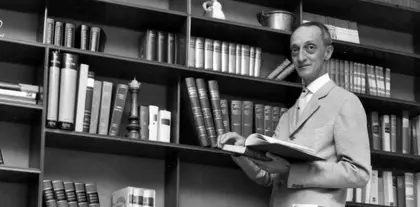Superstar American film director Quentin Tarantino likes to remember how in the 1980s he worked in a video store and discovered many Italian films. One of them – Caliber 9, directed by Fernando Di Leo and released in 1972 – he considered to be a masterpiece.
JOIN US ON TELEGRAM
Follow our coverage of the war on the @Kyivpost_official.
Some critics say its influence can be seen in Tarantino’s “Pulp Fiction” and “The Hateful Eight.”
- Access the most up-to-date war in ukraine update in the Kyiv Post’s daily news items today.
- Access the newest Ukraine news items published today.
Few people know that the film was based on the stories of an Italian writer with a Ukrainian surname. Volodymyr Valerianovych Shcherbanenko, writing under the pseudonym Giorgio Scerbanenco, became the father of the Italian noir detective novel. He offered realistic, hard-boiled depictions of the criminal underworld. Unusual plots, a masterful writing style, and the ability to maintain intrigue and suspense, all made Scerbanenco very popular. But it wasn’t the only component of his success.
He managed to insert the heroes of his works into the context of ordinary life. Some even suspected he was describing actual events. The novels are set in Italy, in places and circumstances well known to his readers – especially in Milan, where the author lived most of his life.
How did Scerbanenco wind up in Italy?
His mother, Leda Giulivi, was Italian. She came from Rome and was fond of art. His father, Valerian Afanasiyovych Shcherbanenko, taught Latin and Greek at Kyiv University and was the son of a rich Ukrainian landowner and a Polish countess.
His parents had met in Rome in 1907. In 1908, they married and moved to Kyiv. Volodya was born there in 1911. Later, he would sign his personal letters with this name. The First World War took him with his mother to Italy, while his father remained in Kyiv. The tragic events of those years led to the family losing contact. Then, in 1919, Leda and her eight-year-old son went back to Kyiv to look for Valerian. They learned that he had been shot by the Bolsheviks.
Leda saw a way out only by returning home. She and her son reached Odesa. They waited a long time for rescue, as officials informed Leda that she had lost her Italian citizenship when she married a subject of the Russian Empire. However, fate spared the mother and her son. They were able to get on a steamer and eventually wound up in a refugee camp in Trieste.
As Scerbanenco’s daughter Cecilia would later recall, her father suffered all his life because of his brutally severed roots and the misfortune of his people. In his works, all the characters with tragic fates are usually Ukrainians (although Poles and Russians are also present).
Eventually Volodymyr and his mother moved from Rome to Milan. Leda had difficulties finding a mental balance. Financial hardship added to their troubles. He worked in a factory, then as a Red Cross nurse. Later he would say:“Poverty poisons, makes one petty, and anyone who writes should not be afraid, should be free. It took me years to free myself from my inferiority complex.”
The dark side of Milan
Scerbanenco educated himself and made his way into artistic and journalistic circles. His first published article concerned the works of German philosopher Arthur Schopenhauer. In the 1930s, Volodymyr worked as an editor and journalist in Milan. He began writing novels – at first mostly love stories. He didn’t give up his exotic, Slavic surname, although he did take on an Italian first name – Giorgio. In 1935, he was granted Italian citizenship.
In 1943, Scerbanenco tried to get a university education but time the German occupation had begun. Scerbanenco secretly crossed the Swiss border in the Alps. He spent over a year in refugee camps. Loneliness and a sense of tragedy from observing the fates of war victims stimulated the writer’s darker instincts, which drew him to the noir genre.
After the war, Scerbanenco edited a number of magazines – mainly publications for women. His advice columns with answers to letters from female readers in difficult post-war situations became especially popular.
It was from these thousands of women’s letters that Scerbanenco gathered material for stories and novels. Practically nothing needed to be invented, because life is the best playwright. Giorgio wrote prolifically and published under pseudonyms so as not to incur the wrath of publishing houses seeking exclusive rights to his work.
By the 1960s, his noir stories had made Scerbanenco very popular. In them, he highlighted the dark side of Italy’s post-war economic boom and urbanization, depicting individuals vulnerable to crime. Scerbanenco’s heroes often become, in his own words, “people who are used to being in the shadows”: ex-convicts, gangsters or people exploited by them, many who are desperately trying to escape from the criminal world.
According to one film director, Scerbanenco, like no one before him, was able to depict the dark side of the 1960s, to look deeper than the illusion of affluence in an era that for too long was presented only in bright colors.
Giorgio Scerbanenco passed away in 1969, and many of his books have been republished and adapted for film. Since 1993, a prize named after him has been awarded annually in the Alpine town of Courmayeur, honoring the best Italian noir writers. The award jury is chaired by Cecilia Scerbanenco. In 2018, she published a biography of her father, “The Story Manufacturer.”
Few, however, are aware that this Italian writer, who also inspired one of America’s most beloved film directors, Quentin Tarantino, was of Ukrainian orgin.
You can also highlight the text and press Ctrl + Enter



